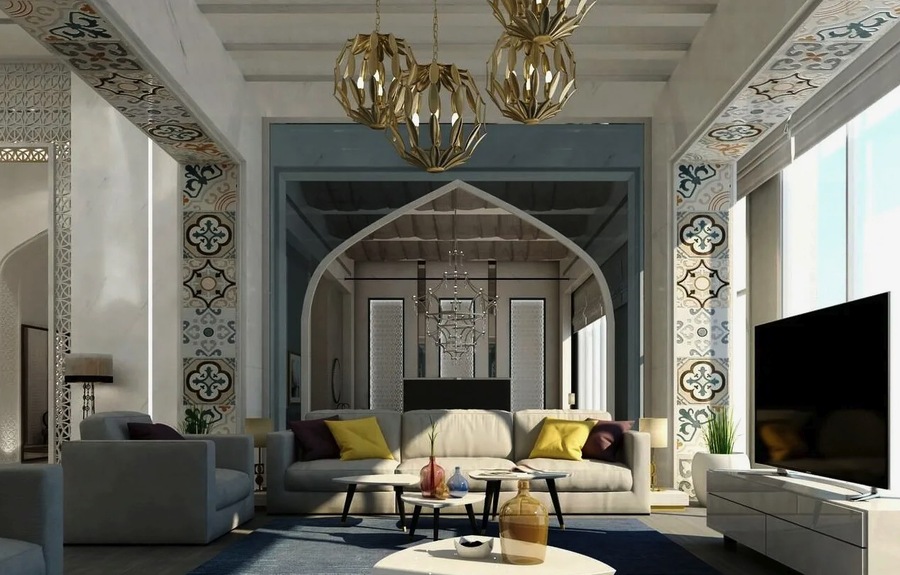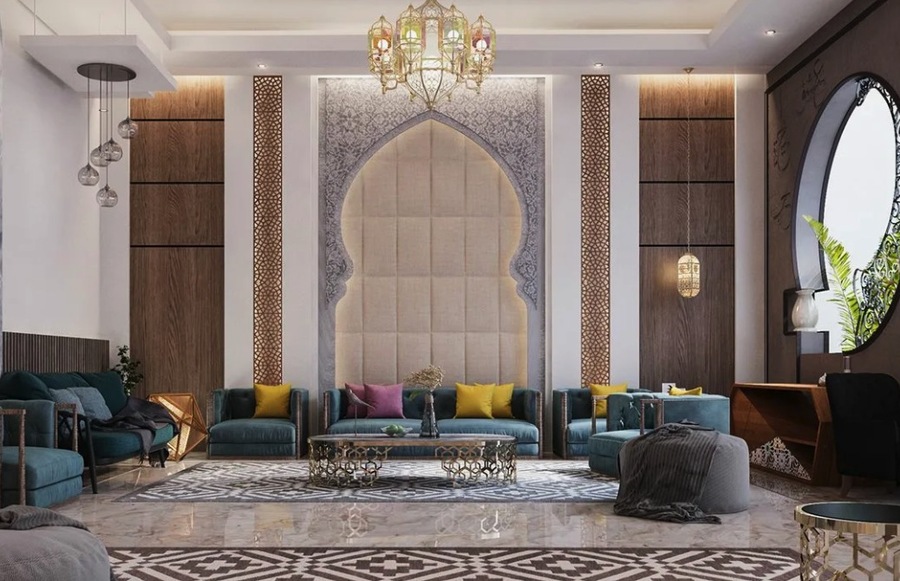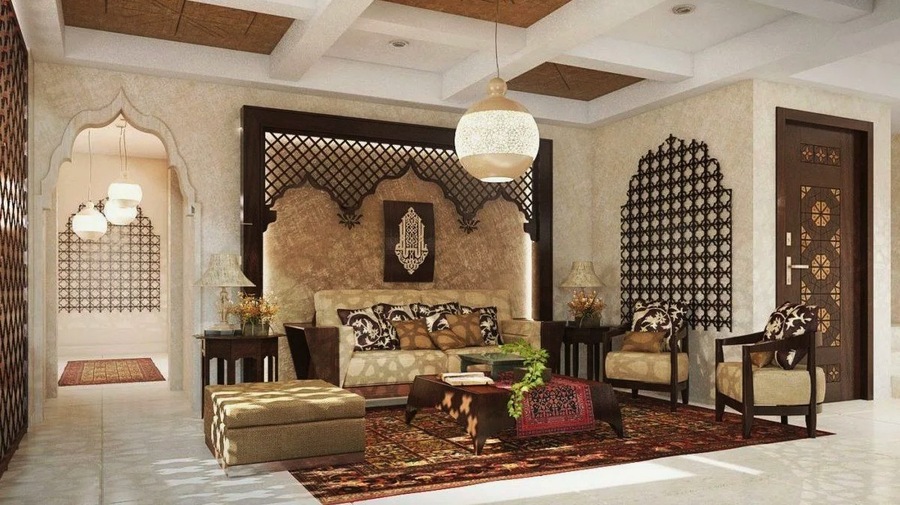Arab style in interior design is a captivating ethnic trend that emerged in the 7th century, influenced by the rich tapestry of Islamic culture, history, and traditions from Eastern countries. This style is renowned for its vibrant decorations, intricate ornaments, and expressive motifs, creating an enchanting atmosphere that transports one to a different era. The Arab style encompasses architectural elements from various Arab nations, including Turkey, Egypt, the Arab Emirates, Morocco, Saudi Arabia, and Syria. The pinnacle of its influence was during the early 18th century when Islamic architecture flourished. To bring this timeless style into your home or event, Rental Joy offers a variety of Arab-style furniture and decor, perfect for creating an authentic and luxurious ambiance.
Key Features of Arab-Style Interiors
Arab style in interiors is easily recognizable by several distinctive features:
- Absence of Figurative Art: Due to Islamic prohibitions, there are no depictions of people or animals. Instead, ornate patterns, geometric designs, and floral motifs dominate. This adherence to religious tenets creates a unique and visually appealing aesthetic emphasizing abstraction and symmetry.
- Rich Ornate Patterns: Walls and ceilings are often covered with elaborate patterns and intricate paintings. These designs, usually inspired by nature and geometry, create a sense of depth and complexity, transforming ordinary spaces into works of art.
- Vibrant Colors: Bold and warm colors like red, orange, yellow, and brown are prevalent in Arab culture. These colors evoke warmth and hospitality, essential elements in Arab culture, making spaces feel inviting and lively.
- No Traditional Doors: Instead of conventional doors, arched doorways are draped with heavy curtains. These drapes, often made from luxurious fabrics like silk and brocade, add an element of mystery and grandeur.
- Abundant Lighting: Large chandeliers and numerous smaller lamps and sconces provide rich lighting. The interplay of light and shadow created by these fixtures enhances the intricate patterns and textures of the interior.
- Unique Furniture: Low sofas, cushions, ottomans, and intricately carved low cabinets replace traditional tables and chairs. This furniture is designed for comfort and relaxation, reflecting the importance of hospitality in Arab culture.
- Oriental Decor: Decorative metal dishes, vases, jugs, cold weapons, wrought iron candlesticks, and embroidered pillows enhance the exotic atmosphere. Each item tells a story and adds to the space’s overall narrative.
Origins of the Arab Style
At the core of Arab life is religion, which influences all aspects of living, including interior design. The principles of Arab interior design remained a mystery until the mid-19th century when Europe discovered the luxury of Oriental decor. Unlike the ever-changing styles in European interior design, the Arab style is conservative and steeped in tradition, unchanged for centuries. This adherence to tradition lends the style its historical value.
As Islamic scripture prescribes, the prohibition against depicting living beings in art results in various geometric patterns and cyclic ornaments. Additionally, the nomadic lifestyle of ancient Arabs influenced the use of textiles, canopies, and an abundance of pillows and carpets, reflecting their historical need for portable comfort during long journeys.

Furniture in Arab Interiors
Despite the luxurious feel, Arab interiors have minimal furniture. The living room often features a low sofa upholstered in sumptuous fabrics like velvet or satin, complemented by small tables and ottomans. Comfort is paramount, with handmade bedspreads and intricate patterns adorning the furniture. A tea area with a small table and cushions for seating is common in larger living rooms.
Studio apartments often combine the kitchen and dining areas with a large, carved wooden dining table and upholstered chairs. The bedroom’s focal point is a grand bed adorned with decorative pillows and a beautiful bedspread, often surrounded by a canopy. The headboard is a significant feature, made of wood and decorated with ornate designs.
Traditional Arab interiors typically do not use cabinets. Instead, items are stored in large, carved chests, shelves, or nightstands. Dressing rooms are often niches with intricately carved wooden doors.
Evolution and Modern Adaptations
Over the centuries, the Arab style has evolved while maintaining its core elements. Modern adaptations of Arab interiors blend traditional motifs with contemporary design principles, creating spaces that are both timeless and current. These modern Arab interiors might feature minimalist lines with rich textures and patterns, offering a unique fusion of old and new.
Materials such as glass, metal, and concrete are now incorporated alongside traditional wood and textiles, adding a contemporary touch without compromising the style’s authenticity. This fusion is particularly popular in cosmopolitan cities like Dubai, where the blend of heritage and modernity is a defining characteristic.

Creating an Arabian-Style Home
If the Arabian style inspires you and you wish to infuse your home with its exotic charm, companies like Rental Joy in the UAE can help. They offer a wide range of Arab-style furniture, such as a two-seater bench pouf for just 300 dirhams, allowing you to create an authentic and luxurious Arabian interior.
To achieve a cohesive Arab-style interior:
- Start with a neutral base of warm, earthy tones and layer it with vibrant accents.
- Use rich fabrics like silk and velvet for cushions, drapes, and upholstery.
- Incorporate intricate patterns through wallpaper, rugs, and decorative items.
- Remember the importance of lighting; opt for ornate chandeliers and smaller lamps to create a warm, inviting ambiance.
Conclusion
In summary, the Arab style in interior design is a celebration of rich cultural heritage, vibrant colors, and intricate patterns. It transforms any space into a luxurious and enchanting retreat, reflecting centuries of tradition and craftsmanship. Whether furnishing a home in Dubai or anywhere else, embracing the Arab style can bring a sense of history, luxury, and warmth to your living spaces. With a careful selection of furniture and decor, you can create a beautiful and functional space, a true testament to the enduring allure of Arab design.
I am a dedicated entrepreneur and tech enthusiast from Silicon Valley. After earning a degree in computer science from Stanford, I co-founded several startups seeking to disrupt industries with innovative technologies. Besides business, I love to travel and mentor aspiring entrepreneurs, driven by a vision for a better future.
